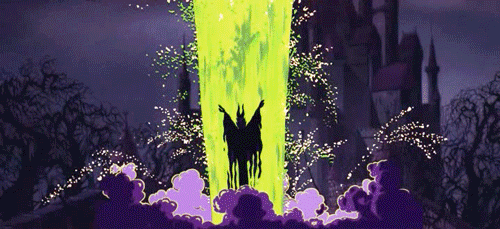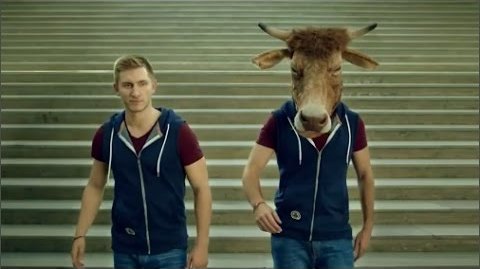
A man and his Base Self. “The mind is a captive [of the Base Self]. Kill your Base
Self and rejuvenate the world... The slayer of the ox is your intellect...” (Rumi,
Mathnawi, III: 2507, 2504-6.)
Self and rejuvenate the world... The slayer of the ox is your intellect...” (Rumi,
Mathnawi, III: 2507, 2504-6.)
I cannot exonerate my self, for the self always commands to evil.
—Joseph (12:53)
Your worst enemy is your self between your two sides.
—The Prophet
(Bayhaqi)
—Joseph (12:53)
Your worst enemy is your self between your two sides.
—The Prophet
(Bayhaqi)
 The
Base Self, our inner demon or ego, is frequently represented as a
mirror image in movies and TV series, because it is not basically
different from ourselves (Gotham, S02E01).
The
Base Self, our inner demon or ego, is frequently represented as a
mirror image in movies and TV series, because it is not basically
different from ourselves (Gotham, S02E01). Our worst enemy is not the devil. The devil’s powers are limited, mainly to those of suggestion (“whispering”). No, our greatest enemy is an ally of the devil, and it is all the more dangerous because it lies not outside, but within us. It is called the Base Self (nafs al-ammara: the Commanding, Compelling or Inciting Self, also known as the Carnal Soul, the self that commands to evil). The existence of this self has led to the erroneous concept of Original Sin. What is needed is to recognize the existence of this self, and to control, tame and purify it.
According to a famed Sufi, Kâshâni, the Base Self wants to play God: “The lower self always wants people to obey moral precepts only as it expounds them, to love it more than anything else. The lower self wants others to fear it in all situations, clinging to hope in its mercy, in the same way that God demands these things from His devotees.”
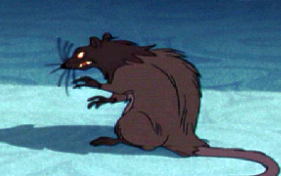 Another Sufi, Hujwiri—who was one of the first to write about Sufism—said:
Another Sufi, Hujwiri—who was one of the first to write about Sufism—said:
I saw my lower self in the form of a rat. I asked, “Who are you?” It replied, “I am the destruction of the heedless, for I incite them to wickedness. I am the salvation of the friends-of-God, for if it were not for me, they would be proud of their purity and their actions. When they see me in themselves, all their pride disappears.
This has been compared to a peacock in Sufism: a peacock struts its beautiful feathers, but when it looks down at its ugly feet, all its vanity is deflated.
Two prayers of the Prophet regarding this Base Self are:
Two prayers of the Prophet regarding this Base Self are:
- “My God, do not leave me to my self for the blink of an eye and do not revoke the good things you have given me.”
- “Do not leave me to my self. If you do, my self will draw me towards evil and distance me from the good.”
And according to another Sufi who wrote one of the great treatises on Sufism, Qushayri: “The lower self likes praise. It continually enjoins a person to put on pretensions, so that people will compliment it. Indeed, there are many worshipers and ascetics who are thus controlled by the lower self.”
Animal Traits
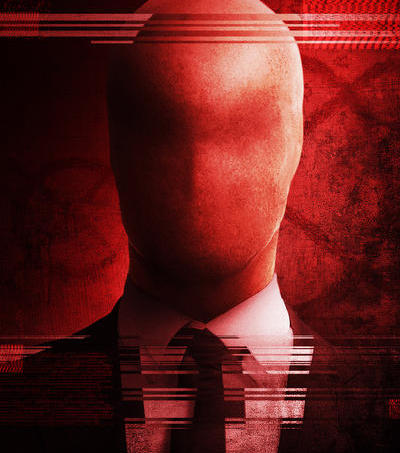 The Base Self is originally faceless, but even in this condition it will fight you. With our thoughts, words and actions, we determine what our “face” will be.
The Base Self is originally faceless, but even in this condition it will fight you. With our thoughts, words and actions, we determine what our “face” will be. A Sufi Master once took off his ring and told his disciple to look at people through the ring. When the disciple did so, they appeared to him as animals—some as a fox, some as a wolf, some as a goat, and so forth.
Here is the meaning of this story:
When God opens one’s “Eye of the Heart” in Sufism, the inner nature of things is revealed. One of the consequences is that one perceives the attributes of people. Since many are in the nature of wild beasts, they appear to that person as wild animals.
Think of it this way: each of us feeds an animal inside us, which would
more properly belong in a barn or a zoo, and we have no inkling of its
presence within.
That human beings can possess animal attributes is recognized in fables as well. The following animal attributes correspond to various traits: A donkey is stubborn. A dog is loyal to its master, but attacks everyone else. A snake is treacherous and hostile. A fox is sly and cunning. A mouse steals. A cat is ungrateful. A wolf represents anger and aggression. In Fariduddin Attar’s long Sufi poem Language of the Birds, each bird represents a specific “human type with its own strengths and weaknesses” (Chittick). And similarly for other animals such as a scorpion, bear, and so on.
That human beings can possess animal attributes is recognized in fables as well. The following animal attributes correspond to various traits: A donkey is stubborn. A dog is loyal to its master, but attacks everyone else. A snake is treacherous and hostile. A fox is sly and cunning. A mouse steals. A cat is ungrateful. A wolf represents anger and aggression. In Fariduddin Attar’s long Sufi poem Language of the Birds, each bird represents a specific “human type with its own strengths and weaknesses” (Chittick). And similarly for other animals such as a scorpion, bear, and so on.
Remember
that in the Imaginal World, emotions and abstract concepts take on the
shape of concrete things. This is really what it’s all about.
A sheep is the most innocent animal, and thus the best. Chimeras, composed of various animal parts, are used to represent a composite of animal natures. According to the Secret Lore of Sufism (ilm al-ladun), there exist as many kinds of animals in the world as there are temperaments of the self.
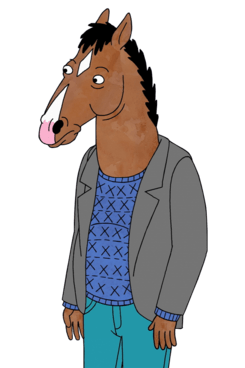 The way to get rid of animal attributes is to become endowed with Human attributes. “Human” is capitalized here because it indicates the Perfect Human, who is also clothed in divine attributes. There is nothing of animal qualities left in such a person. Much
inner struggle is necessary in order to escape the hegemony of animal
attributes. On the other hand, not only progress, but regress is also
possible in life’s journey. When humans commit a particularly heinous
sin, they can regress to the nature of even worse animals than before.
This is what is meant in the Koran by “turning into apes” (2:65, 5:60,
7:166), implying that for their transgressions, they had incurred the animal attributes belonging to simians (they themselves chose to be such).
The way to get rid of animal attributes is to become endowed with Human attributes. “Human” is capitalized here because it indicates the Perfect Human, who is also clothed in divine attributes. There is nothing of animal qualities left in such a person. Much
inner struggle is necessary in order to escape the hegemony of animal
attributes. On the other hand, not only progress, but regress is also
possible in life’s journey. When humans commit a particularly heinous
sin, they can regress to the nature of even worse animals than before.
This is what is meant in the Koran by “turning into apes” (2:65, 5:60,
7:166), implying that for their transgressions, they had incurred the animal attributes belonging to simians (they themselves chose to be such).
A sheep is the most innocent animal, and thus the best. Chimeras, composed of various animal parts, are used to represent a composite of animal natures. According to the Secret Lore of Sufism (ilm al-ladun), there exist as many kinds of animals in the world as there are temperaments of the self.
 The way to get rid of animal attributes is to become endowed with Human attributes. “Human” is capitalized here because it indicates the Perfect Human, who is also clothed in divine attributes. There is nothing of animal qualities left in such a person. Much
inner struggle is necessary in order to escape the hegemony of animal
attributes. On the other hand, not only progress, but regress is also
possible in life’s journey. When humans commit a particularly heinous
sin, they can regress to the nature of even worse animals than before.
This is what is meant in the Koran by “turning into apes” (2:65, 5:60,
7:166), implying that for their transgressions, they had incurred the animal attributes belonging to simians (they themselves chose to be such).
The way to get rid of animal attributes is to become endowed with Human attributes. “Human” is capitalized here because it indicates the Perfect Human, who is also clothed in divine attributes. There is nothing of animal qualities left in such a person. Much
inner struggle is necessary in order to escape the hegemony of animal
attributes. On the other hand, not only progress, but regress is also
possible in life’s journey. When humans commit a particularly heinous
sin, they can regress to the nature of even worse animals than before.
This is what is meant in the Koran by “turning into apes” (2:65, 5:60,
7:166), implying that for their transgressions, they had incurred the animal attributes belonging to simians (they themselves chose to be such).
The great Sufi poet and mystic Rumi says (with reference to the body, which we have to distinguish from the Base Self):
Night
and day you are nourishing your body. Now this body is your horse, and
this lower world is its stable. The food of the horse is not the food of
the rider; the rider has his own kind of sleeping and eating and taking
enjoyment. But because the animal and the bestial have the upper hand
over you, you have lagged behind with your horse in the stable for
horses and do not dwell in the ranks of kings and princes of the world
eternal. Your heart is there, but inasmuch as the body has the upper
hand, you are subject to the body’s rule and have remained its prisoner.
(Discourse 4.)
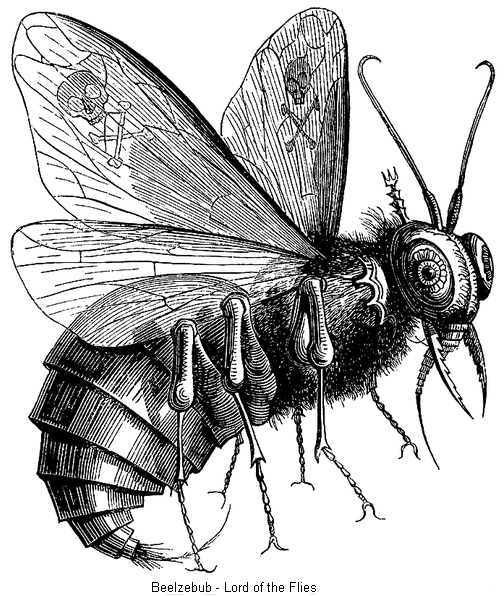 The Fly That Defeated the Eagle
The Fly That Defeated the Eagle
The Turkish Sufi poet Yunus Emre observed:
A fly hurled an eagle to the ground
It’s true and not a lie, I too saw the dust it raised.
It’s true and not a lie, I too saw the dust it raised.
As Master Kayhan elaborated:
The self is a fly. An eagle has the strength of fifty thousand flies. It
can knock a big man down. A clean man of religion, a dung fly can ruin
him. A dung fly hurls a great man of knowledge to the ground. Although
God has granted us all this, we can’t give up a fly. Our self is a fly,
wherever it sees dung, that’s where it’ll dive. We don’t give up a fly.
(TPM, p. 140.)
Nasruddin Hodja’s Donkey
The satirical Sufi saint Nasreddin (also known as Mulla Nasrudin) is trying to get to the big city from his little town. He faces the city. The problem is, his ass opposes him every inch of the way.
The pangs of desire
Nasruddin Hodja was riding his donkey on his way to the orchard. His donkey was male. Now it was May, and a female donkey had urinated as she passed by. The Hodja’s donkey stuck his nose in the soil and wouldn’t budge. He hit him, he drew blood, uh-uh.Nasruddin Hodja emptied the fodder sack, he filled it with that urinated soil and tied it to the animal’s mouth. That night the animal brayed until morning. He’s hungry! The next morning they went again. The neighbor has a female donkey, the hungry donkey didn’t even see her. He went to the orchard, he left the donkey hungry for another couple of hours. Then he leaned over and said into his ear, ‘If you repent, I’ll let you eat.’ Then he fed him. [The Hodja’s ass, of course, is one of the best symbols for the Base Self.]
Donkey of a self
Nasruddin Hodja is going to the orchard. The donkey is unladen. He’s thrown its saddle on it, they’re going.
A neighbor said, ‘Why don’t you ride on it?’ The Hodja replied, ‘You haven’t been riding your donkey, your self, for forty years. Doesn’t your case bother me more? I don’t say anything to you. Nor do you listen to me. I didn’t get on it for five minutes, that bothers you.’(TPM, p. 400-401.)
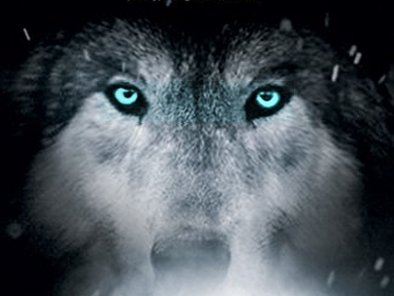
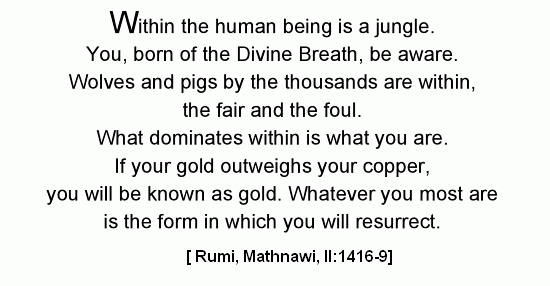

The existence of the Base Self has been recognized in literature as well. In Hermann Hesse’s Steppenwolf
(1927), the hero, Harry Haller, is described as having two natures: one
high, the spiritual nature of man, and the other low and animalistic, a
"wolf of the steppes."
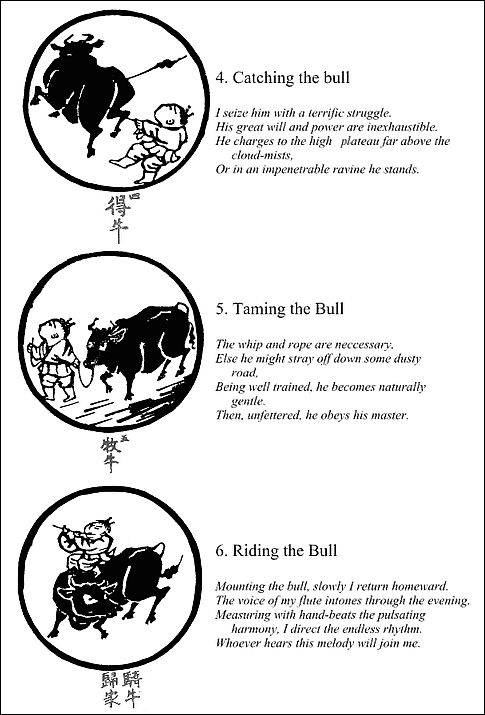
A
selection from the “Ten Bulls” or “Ten Ox-Herding Pictures,” a sequence
of pictures and poems in Zen Buddhism depicting the progress of a
disciple towards Enlightenment. As with Rumi's ox, the Base Self (though
not recognized as such in that tradition) is portrayed as an ox (or
bull, or cow).
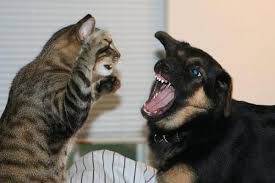
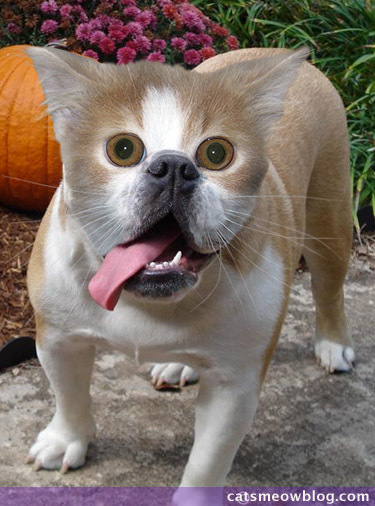 Two
other animals that share the characteristics of the Base Self are the
cat and dog, shown here in a fight. In one of Doris Lessing's
Sufi-inspired novels, Memoirs of a Survivor
(1974), Hugo, the cat-dog, a chimera and a bizarre freak, in the end
turns into “a splendid animal, handsome, all kindly dignity and command”
(p. 190). Even so, purifying the Base Self from its Baseness yields the
Purified Self in the end, which is a wonder to behold. Likewise, at the
end of the novel, the narrator encounters a beautiful version of
herself. But this requires much inner work.
Two
other animals that share the characteristics of the Base Self are the
cat and dog, shown here in a fight. In one of Doris Lessing's
Sufi-inspired novels, Memoirs of a Survivor
(1974), Hugo, the cat-dog, a chimera and a bizarre freak, in the end
turns into “a splendid animal, handsome, all kindly dignity and command”
(p. 190). Even so, purifying the Base Self from its Baseness yields the
Purified Self in the end, which is a wonder to behold. Likewise, at the
end of the novel, the narrator encounters a beautiful version of
herself. But this requires much inner work.
Your Goose Is Not Cooked
 Because of its low intelligence and temperamental nature, the goose is one of the many symbols for the Base Self in Sufism. A Turkish poet, Kaygusuz Abdal, composed a poem entirely devoted to the goose, highlighting the difficulties of taming the Base Self:
Because of its low intelligence and temperamental nature, the goose is one of the many symbols for the Base Self in Sufism. A Turkish poet, Kaygusuz Abdal, composed a poem entirely devoted to the goose, highlighting the difficulties of taming the Base Self:
I got a goose from the woman
Its neck longer than a pipe
Enough to feed Forty Sages
Been boiling for forty years, and still it isn't cooked
Its neck longer than a pipe
Enough to feed Forty Sages
Been boiling for forty years, and still it isn't cooked
Eight of us hewing wood
Nine of us stoking fire
With raised neck the goose looks on
Been boiling for forty years, and still it isn't cooked
Nine of us stoking fire
With raised neck the goose looks on
Been boiling for forty years, and still it isn't cooked
We paid a small sum for the goose
Its flesh stiffer than its bone
Outlived both ladle and caldron
Been boiling for forty years, and still it isn't cooked
Its flesh stiffer than its bone
Outlived both ladle and caldron
Been boiling for forty years, and still it isn't cooked
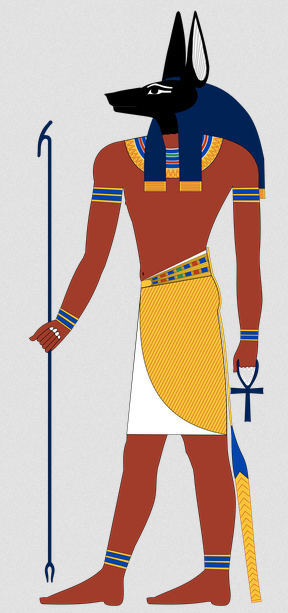 If only the Base Self could be purified, it would be enough bounty for forty sages. The trouble is, even forty years may not be enough to bring it to the required purification.
If only the Base Self could be purified, it would be enough bounty for forty sages. The trouble is, even forty years may not be enough to bring it to the required purification.
( The Black Pearl (2005), p. 180.)
Anubis, the jackal-headed “god” of the afterlife in ancient Egypt, deriving from the fact that jackals scavenged in graveyards. The Egyptians had many other deities with animal heads and human bodies. As the Master observed: “These human-bodied, animal-headed statues are all within a person. They describe various levels of selfhood. A master witnesses these in his own body during his period of asceticism.”
The Three Fears of the Base Self
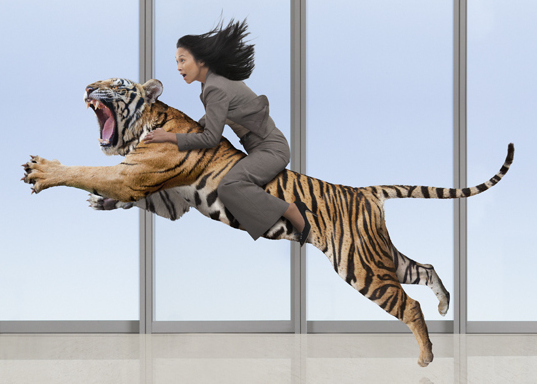
“S/he who rides a tiger is afraid to dismount”—Chinese Proverb.
Master
Kayhan said: “The greatest thing is to control the self.” The way to do
this, he said, is to stay away from Illicit Gain, from Illicit Lust
(extramarital sexual relations), and to utilize its fears:
 The self fears three things: hunger, Prayer [the Islamic Formal Prayer (salat, namaz)], death. It fears nothing else. And the person who knows God, who fulfills God’s commandments,
fears the self and nothing else. The person who fulfills the orders of
God and His Prophet is afraid: ‘Oh, is my self going to commit an error?’
The self fears three things: hunger, Prayer [the Islamic Formal Prayer (salat, namaz)], death. It fears nothing else. And the person who knows God, who fulfills God’s commandments,
fears the self and nothing else. The person who fulfills the orders of
God and His Prophet is afraid: ‘Oh, is my self going to commit an error?’
In its ferocity, the Base Self is just like a tiger—a
tiger that is our enemy. If we dismount it for even an instant, it will
surely put us down. On the other hand, whoever tames their tiger
becomes a sage, a saint.
The Grand Saint On the Base Self
 So
how do we tame the Base Self? A great Sufi saint, Osman Badruddin of
Erzurum, has said: “Give the self its rights, but deny it its
pleasures.” The Grand Saint Abdulqader Geylani, one of the greatest
saints of all, explains how we need to keep the Base Self on a tight
leash, and how we have to treat it like the enemy it is:
So
how do we tame the Base Self? A great Sufi saint, Osman Badruddin of
Erzurum, has said: “Give the self its rights, but deny it its
pleasures.” The Grand Saint Abdulqader Geylani, one of the greatest
saints of all, explains how we need to keep the Base Self on a tight
leash, and how we have to treat it like the enemy it is:
The
rights of the self are the necessary amount of food, drink, clothing,
and shelter. Its pleasures are the things it likes, its lusts, and its
caprices. Give it its rights in accordance with the measure of the Holy
Law. Always feed it with what is Allowed or clean, never that which is
Forbidden or tainted. Be content with little, as long as it is allowed.
Accustom your self to this.
If
you desire liberation, oppose your self where obedience to your Lord is
concerned. If your self tends towards obeying Him, concur with it. If
it inclines towards error, oppose and struggle against it.
Do
not remove the stick of struggle from the back of your self. Do not be
fooled by its tricks. It will appear to sleep; do not be taken in.
Neither would you be off your guard in the presence of a carnivorous
beast that feigns sleep and drowsiness. For it is seeking a chance all
the while that it seems lethargic and somnolent. It is in its predatory
nature to do so.
Now the self is just like a predator. It acts as if it were sleepy and drowsy, yet the moment it finds its opportunity, it strikes.
This self makes a show of external obedience, docility, and compliance
with what is good; yet it is hiding the exact opposite within. So be
very careful with it in matters where it appears submissive.
Try
to heal your self. Say to it: “Whatever good you do is to your own
benefit, and what evil you commit is to your suffering. Whatever you do,
whether good or ill, will return to you.” Struggle against your self.
For God has said: “Whoever struggles for Our sake, We shall surely guide
to the straight path” (29:69), and “If you aid God in His religion, He
will aid you” (47:7).
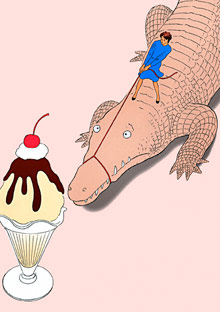 Never
give the self any room, never tolerate it. Do not obey its demands.
Only then will you find salvation and liberation. Never condescend to
smile at it. If it tells you a thousand things, answer only one, until
you are sure that its behavior is rectified and it is quiescent. If it
requests anything belonging to its pleasures and capricious desires,
always postpone it, saying: “Wait until Paradise.”
Never
give the self any room, never tolerate it. Do not obey its demands.
Only then will you find salvation and liberation. Never condescend to
smile at it. If it tells you a thousand things, answer only one, until
you are sure that its behavior is rectified and it is quiescent. If it
requests anything belonging to its pleasures and capricious desires,
always postpone it, saying: “Wait until Paradise.”
Accustom
it to the patience of want. Never accept a word of what it says. For
its propensity is always towards evil. What it wants you to do is evil,
without the shadow of a doubt. If you must answer it, let your reply
always be negative. Opposition to the self is the road to its
edification. Patience on this path has an end. Patience is temporally
finite, yet its fruits are infinite.
(Quoted from Fath al-Rabbani in The Station of No Station (2001), pp. 119-120. Emphasis added.)
Keep Your Dragon in the Snow
A so-called dragon hunter went to the mountains to trap a dragon. He searched the mountains and finally discovered the frozen body of a great dragon in a cave high up one of the tallest peaks. The man brought the body to Baghdad. He claimed he slew the dragon single-handed and exhibited it on the bank of the river. Hundreds of people came to see the dragon. The warmth of the Baghdad sun gradually warmed the dragon’s body, and it began to stir, coming slowly out of its winter sleep. The people screamed and stampeded, and many were killed. The dragon hunter was frozen in fear, and the dragon ate him in a single gulp.
Your lower self is that dragon, a savage, bloody tyrant.
It is not dead, merely frozen.
Keep your dragon in the snow of self-discipline.
Do not transport it to the sunshine of Baghdad.
Let that dragon of yours remain dormant.
Should it be released, it will devour you.
Rumi (Mathnawi, III: 976-77, 995-8, 1003-7, 1029-60. Quoted from James Fadiman & Robert Frager (eds.), Essential Sufism, Chapter 4.)
Of course, flying, fire-breathing dragons are mythical animals. Symbolically, fire signifies anger and flight represents spiritual elevation. The two are polar opposites; a dragon is capable of both.
When you look at the etymology of “dragon,” it originally meant “large serpent.” Indeed, Rumi’s tale in Persian begins with “snake” and continues intermittently with “dragon” in this latter sense. In real life (though thankfully not in our day), there were dinosaurs, which have also been called “thunder lizards.” The carnivorous kind can be considered equivalent to dragons in rapacity.
As Rumi declares elsewhere:
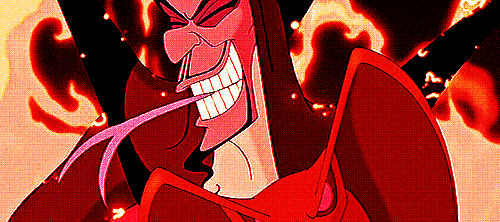 T
T he
greatest [striving] is to mingle with friends who have turned their
faces to God [Friends of God: saints] and turned their backs on this
world. For there is no more difficult striving than this, so sit with
righteous friends; for the very sight of them dissolves and naughts that
[Base Self]. It is for this reason that they say that when a snake has
not seen a man [a Perfect Human] for forty years it becomes a dragon;
that is, because it sees no one who would be the means of dissolving its evil and vileness.
he
greatest [striving] is to mingle with friends who have turned their
faces to God [Friends of God: saints] and turned their backs on this
world. For there is no more difficult striving than this, so sit with
righteous friends; for the very sight of them dissolves and naughts that
[Base Self]. It is for this reason that they say that when a snake has
not seen a man [a Perfect Human] for forty years it becomes a dragon;
that is, because it sees no one who would be the means of dissolving its evil and vileness.
(Discourses of Rumi, Discourse 70.)
More examples could perhaps be given, but enough has been said to show the true nature of the Base Self, and the grave threat it poses to every one of us.
(The animated graphics show characters from two Walt Disney movies: Maleficent the sorceress from Sleeping Beauty (1959) and the evil vizier Jafar from Aladdin (1992). The transformations show the Base Self in open rebellion, revealing its true face.)
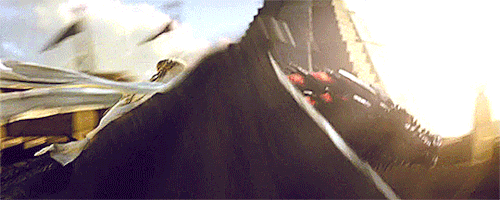
If you can tame your dragon, if you can extinguish its fire, it will help you fly.
According to sinologist James Legge, the Chinese version of the dragon symbolizes the Superior Man—the Perfect Human of Sufism.
(Daenerys in Game of Thrones, S05E09.)
According to sinologist James Legge, the Chinese version of the dragon symbolizes the Superior Man—the Perfect Human of Sufism.
(Daenerys in Game of Thrones, S05E09.)

